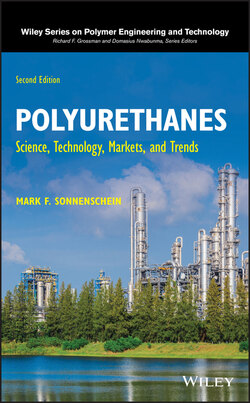Читать книгу Polyurethanes - Mark F. Sonnenschein - Страница 11
PREFACE
ОглавлениеI want to begin by thanking the people and organizations that bought the first edition of Polyurethanes: Science, Technology, Markets, and Trends. I have received many encouraging and constructive comments since it appeared at the end of 2014. At the same time I have also had a certain amount of angst about the number of errors in the book, most of them typographical, but not all of them! In addition, I have been acutely aware as time has passed, even over just 6 years, that the polyurethane industry is continuously changing and evolving. The “Science” and “Technology” parts of the first edition title have changed somewhat, but the “Markets” and “Trends” components of the first edition were badly in need of updating. What was also striking was how third‐party industry forecasts made in 2014 about subsequent years were in most cases wrong, demonstrating how poorly crystal ball analyses of economic activity perform. In this second edition there is much less attention paid to these prognostications.
An interesting macrotrend at the time of this writing is the rapid expansion of global capacity with only moderate growth occurring now and in the future. This assures that producer prices will remain under pressure and help maintain low price inflation for the foreseeable future. This may also result in additional consolidation in the polyurethanes industry, or the spinning out of polyurethane businesses from chemical conglomerates as was see when Bayer AG spun off its polyurethane assets into a separate company called Covestro AG. An additional market complication is the introduction of large chemical concerns that represent and depend on national subsidies, such as those appearing in China and Saudi Arabia. As a statement of a societal commitment apart from market forces, they are capable of distorting market supply and pricing. Whether by consolidation or spinning out of assets, the ability of the surviving companies to efficiently and effectively allocate and spend capital in the prevailing economic environment could be a continuing element in the polyurethanes industry story.
This edition adds two new special chapters at the end: Chapter 13 on polyurethane hybrid polymers and Chapter 14 on polyurethane recycle. As the reader will see, both topics cover nascent technologies in terms of the scientific progress and industrial intent to commercialize in these technology fields. Polymer hybrids are often conceived in the belief that if two different polymers are good, then their combination (or hybridization) will be even better. While this has not historically been found true for a number of reasons, there are a number of instances for polyurethanes where polymer backbone hybridizations are beneficial, making this technology area potentially ripe for growth in the future.
Polyurethane recycle – the subject of Chapter 14 – is a subset of the much larger topic of plastics recycle. However, unlike soda straws, water bottles, and disposable food packaging, polyurethanes are usually not found in articles that are commonly thrown away. There is no developed municipal collection and distribution system for acquiring polyurethanes, separating them from the objects they are a part of, and readying them for chemical cleanup and reversion back to useful building blocks. However, regulations, especially those emanating from the European Union, requiring end‐of‐life stewardship of things such as mattresses and automotive seats – containing significant volumes of polyurethanes – are forcing producers to develop technology and commercial partnerships. This industrial evolution will permit polyurethane recycle either through low‐value physical incorporation or by chemical transformation of the polyurethane polymer into useable feedstocks for making new materials. If governmental regulations create price inelastic demand for these materials, then the methods of their production and the value they bring will become a topic of increasing importance into the future.
Mark F. Sonnenschein
Midland, MI
